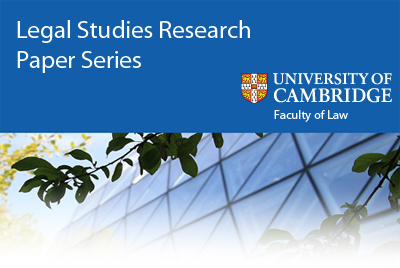 The Faculty has published Volume 6 Number 4 of the University of Cambridge Faculty of Law Legal Studies Research Paper Series on SSRN.
The Faculty has published Volume 6 Number 4 of the University of Cambridge Faculty of Law Legal Studies Research Paper Series on SSRN.
This issue includes the following articles:
Matthew H. Kramer: Political Justification (12/2015)
Throughout the past several decades, the matter of political justification has been one of the central preoccupations of political philosophers in the English-speaking world and beyond. During that time, political philosophers have frequently clashed with one another over the question whether governments are morally required to remain neutral among reasonable conceptions of excellence or human flourishing. Whereas the numerous followers of John Rawls (and kindred philosophers such as Ronald Dworkin) have maintained that a requirement of neutrality is indeed incumbent on every system of governance, other philosophers -- often designated as "perfectionists" -- have argued against the existence of such a requirement. The present essay seeks to elucidate these debates, in which the nature of political justification has been so saliently at issue.
Daniel Peat and Christine Barthelemy: Trade Remedies in the Renewable Energy Sector: Normal Value and Double Remedies (14/2015)
Subsidies within the renewable energy sector are rife. Once stymied by the subsidisation of fossil fuel production, active government support is now advocated as a part of ‘green industrial policy’ aimed at stimulating growth within the sector. This predominantly economically motivated shift provides the positive externality of climate change mitigation, yet leaves certain government support measures vulnerable to countermeasures under WTO law in the form of unilateral countervailing duties. Further, as four investigations in the past three years demonstrate, the same products are often subject to simultaneous anti-dumping duties. This article aims to investigate the interaction between these trade remedies in the RE sector. It examines what lessons can be taken from the reports of the Panel and Appellate Body (AB) in US – AD/CVD and report of the Panel in US – CV/AD Measures, and moves on to an in-depth examination of the 2012 US and 2013 EU investigations into the dumping of photovoltaic products from China. It concludes by reviewing outstanding issues for trade remedies in the RE sector; namely, the appropriate choice of surrogate third country and sampling technique, the accurate calculation of dumping and subsidy effects, and the burden of proof for double remedies.
Jason N. E. Varuhas: The Evolution of the Damages Remedy Under the New Zealand Bill of Rights Act 1990: From Torts to Administrative Law (15/2015)
This paper charts the development of the damages remedy under the New Zealand Bill of Rights, from its inception in Baigent's Case, to one that looked as though it may develop along tort-based lines in the case of Dunlea, and more recently towards what might be described as an “administrative law” or “public interest” conception of the remedy, in the wake of the Supreme Court decision in Taunoa. This public interest conception is based in a particular view of the goals of public law, which more or less equates public law with administrative law i.e. the common law of judicial review. Within this conception public law is not principally concerned with individual rights and the protection of personal interests, but with ensuring public power is properly exercised for the good of society as a whole. The remedial approach within such conception of public law is, like that in administrative law, one focused upon declaratory and specific-type relief. Damages, being a remedy conceptualised traditionally as redressing setbacks to personal interests, is a conceptual outlier and therefore marginalised. The decision whether to award damages is guided principally by public interest concerns, with concerns of individual justice being pushed to the periphery and subordinated to wider concerns over how public power ought to be exercised. The result is an approach to damages far more restrictive than that which prevails in other fields of law which protect rights equivalent to or lesser in importance than those under the Bill of Rights.
The paper is critical of the administrative law approach. Most significantly, such approach confuses the distinctive nature of human rights law, producing incoherence within that field, and stymies the principal function of human rights law: protection of the individual. On the other hand, a tort-based approach, such as that mooted in the Court of Appeal decision in Dunlea, is consonant with and gives effect to the underlying concerns of human rights law. The paper argues that one of the principal reasons for the turn from tort to administrative law is that legal development has been rested on the deeply problematic idea of a grand normative distinction between public law and private law. The paper considers the use of this distinction to shape the damages jurisprudence.
Michael Waibel: Principles of Treaty Interpretation: Developed for and Applied by National Courts? (16/2015)
More than 40 years after the Vienna conference on the law of treaties codified principles of interpretation in the Vienna Convention on the Law of Treaties, their practical operation remains contested and in flux. Neither the ratification of the VCLT by many (though not all) states, nor the general recognition that Articles 31-33 represent customary international law, has resolved the debate over the ‘correct’ approach to interpreting treaties, and international law in general. Debates in international law over the ‘correct’ interpretative approach mirror similar debates in domestic legal systems.
Even though the VCLT’s role in treaty interpretation has been studied extensively, its use in how national courts interpret international law has received far less attention. This chapter examines whether the drafters of the VCLT drafted Articles 31-33 partly with national courts in mind, and how national courts in fact interpret treaties. In considering the practical application of the VCLT’s interpretive principles, the chapter largely leaves aside the normative question whether it is desirable for national courts to interpret treaties based on the VCLT, to the exclusion of domestic canons of interpretation.
Section II sets the scene for treaty interpretation by national courts. It looks at the development of interpretive principles, and asks whether national courts are among their intended users. Section III considers national judges as members of diverse epistemic communities that influence treaty interpretation and explores the value of the VCLT’s minimum harmonisation of interpretive methods, particularly for uniform, private law-making treaties. Section IV considers the doctrinal question of whether national courts are formally bound by the VCLT’s interpretive principles and the empirical question of whether they routinely apply the VCLT even in the absence of a formal legal obligation to interpret treaties in accordance with the VCLT. Section V examines the persistent tendency for national courts to deploy non-VCLT methodologies such as contract and statutory imagery in interpreting treaties.
Brian Cheffins et al: Shareholder Protection Across Time (17/2015)
This Article offers the first systematic attempt to measure the development of shareholder protection in the United States across time. Using three indices developed to measure the relative strength of shareholder protection across nations, we evaluate numerically the protections corporate and securities law have offered shareholders from the beginning of the twentieth century to the present day. We do so by tracking the rights accorded to shareholders across time under three important sources of corporate law, Delaware and Illinois and the Model Business Corporation Act.
Our novel study yields novel results. First, we find that the protections afforded to shareholders by state corporation law have decreased since 1900 but only modestly so. This implies that, contrary to the assumptions of many scholars, state competition in corporate law has not significantly eroded shareholder rights. Second, when we add in measures that count protections provided by federal as well as state law, we find that shareholder protection improved across time. This implies that federal intervention has played a crucial and perhaps underappreciated role in shaping U.S. corporate law. Beyond its specific findings, this study illustrates how empirical analysis of legal trends provides scholars with a new means for analyzing and resolving fundamental questions in corporate law.
Interested readers can browse the Working Paper Series at SSRN, or sign up to subscribe to distributions of the the e-journal.


 Facebook
Facebook  X/Twitter
X/Twitter  Instagram
Instagram  YouTube
YouTube  Flickr
Flickr  LinkedIn
LinkedIn